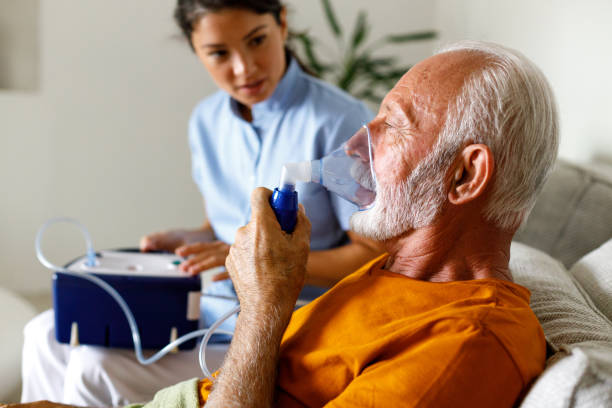Chronic Obstructive Pulmonary Disease (COPD) is a long-term lung condition that affects breathing and lung function. A stethoscope is one of the most important tools doctors use to diagnose and monitor this condition. In this guide, we’ll take a detailed look at how stethoscopes are used in COPD care, the types of stethoscopes available, and why they are essential.
Understanding COPD
COPD is not just one disease—it includes several lung conditions, such as:
- Chronic bronchitis: Inflammation of the bronchial tubes, leading to excessive mucus.
- Emphysema: Damage to the tiny air sacs in the lungs, reducing oxygen exchange.
Symptoms include:
- Persistent cough
- Shortness of breath
- Wheezing
- Chest tightness
Managing COPD often requires regular monitoring of lung function to prevent worsening symptoms and complications.
How Stethoscopes Aid in COPD Diagnosis
Listening to Lung Sounds
Doctors use stethoscopes to listen for abnormal sounds in the lungs. The types of sounds they identify include:

- Wheezing: Indicates narrowing of the airways due to inflammation or mucus.
- Crackles (Rales): Suggests fluid buildup in the lungs or mucus in the airways.
- Diminished breath sounds: This can indicate severe airway obstruction or lung tissue damage.
Initial Diagnosis
During an initial consultation, your doctor may use a stethoscope to:
- Listen for abnormal lung sounds.
- Compare sounds from different lung areas to pinpoint problems.
- Decide if further tests like spirometry or X-rays are needed.
Severity Assessment
The sounds detected with a stethoscope also help determine how advanced your COPD is. For example, severe wheezing or minimal airflow may indicate a need for urgent intervention.
Ongoing COPD Monitoring with Stethoscopes
Detecting Flare-Ups
COPD exacerbations, or flare-ups, are episodes where symptoms worsen rapidly. Using a stethoscope, doctors can detect:
- Increased wheezing due to airway narrowing.
- New crackles are caused by fluid or mucus buildup.
- Reduced airflow in specific lung areas.
Tracking Progress
Regular stethoscope exams allow doctors to monitor changes in lung function over time. This helps them:
- Adjust your treatment plan.
- Evaluate the effectiveness of medications like bronchodilators or steroids.
- Identify early signs of complications like pneumonia or lung infections.
Emergency Situations
During a severe exacerbation, a stethoscope helps doctors decide if you need:
- Oxygen therapy
- Nebulized medications
- Hospitalization for advanced care
Types of Stethoscopes for COPD Management
| Type | Key Features | Best Uses in COPD |
| Acoustic Stethoscope | Basic design; amplifies natural lung sounds. | Ideal for identifying wheezing and crackles during exams. |
| Digital Stethoscope | Converts sound into digital signals for amplification. | Helps hear faint lung sounds or abnormal patterns. |
| Electronic Stethoscope | Records and stores lung sounds for future comparison. | Best for long-term monitoring and research purposes. |
Comparison of Stethoscope Types
| Feature | Acoustic | Digital | Electronic |
| Sound Clarity | Moderate | High | Very High |
| Amplification | None | Yes | Yes |
| Portability | Very Portable | Portable | Less Portable |
| Cost | Affordable | Moderate | Expensive |
| Best For | Basic Diagnosis | Advanced Monitoring | Long-Term COPD Management |
How Stethoscope Sounds Help in COPD Care
| Sound | What It Indicates | Possible Action |
| Wheezing | Narrow airways due to inflammation or bronchospasm. | Adjust inhaler use or prescribe bronchodilators. |
| Crackles | Mucus or fluid buildup, is often linked to infections. | Start antibiotics or increase mucus-clearing therapies. |
| Diminished | Obstruction or advanced lung damage in severe COPD. | Consider oxygen therapy or assess for further lung damage. |
Steps for Proper Stethoscope Use in COPD
- Placement:
- Place the stethoscope on the front, back, and sides of your chest.
- Avoid areas near clothing or background noise.
- Listening Technique:
- Listen during inhalation and exhalation.
- Focus on both the upper and lower lung fields to catch all abnormalities.
- Environment:
- Ensure a quiet room to avoid interference.
- Keep the stethoscope warm to prevent discomfort.
- Sanitization:
- Clean the stethoscope after every use to prevent the spread of infections.
Benefits of Regular Stethoscope Monitoring for COPD

- Early Symptom Detection: Identifies issues before they worsen, preventing hospitalizations.
- Treatment Adjustments: Helps track how well medications are working.
- Improved Quality of Life: Ensures your symptoms stay under control, allowing you to breathe easier.
FAQs
Can you use a stethoscope at home?
Yes, but it requires training to recognize lung sounds. It’s best to rely on healthcare providers for accurate assessments.
Which stethoscope is best for COPD?
Digital or electronic stethoscopes are ideal as they provide clearer sound and allow for long-term monitoring.
How often should COPD patients have lung sounds checked?
At least once during routine checkups and more frequently during flare-ups.
Conclusion
The stethoscope is an invaluable tool for diagnosing and managing Chronic Obstructive Pulmonary Disease (COPD). From listening to lung sounds to tracking progress, it plays a vital role in your care.
Whether it’s identifying wheezing or crackles, regular stethoscope use ensures timely treatment and better control of your condition. Talk to your doctor about the importance of lung monitoring and make it a part of your COPD management plan.


